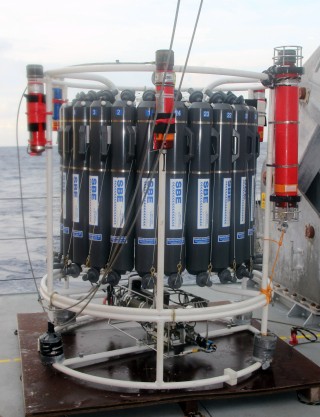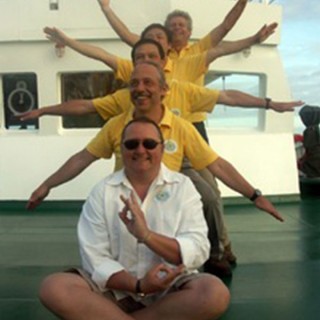
Today was a good day. Even before our 7:00 am kick-off meeting on the Bridge, Leighton, Nathan and Jimbo from the Falkor together with Ko-ichi and James from our science team had been up and busy on the back deck readying the CTD for deployment.
After a quick polishing of the optical sensors (I like to feel I do something more than just write the blog) it was up to the Bridge for our start-the-day meeting with the Captain and then back down below again to watch the CTD be deployed for our background station.
The purpose of today’s cast was two fold. Primarily it was to start a sequence of events in which the ship would transit back and forth over a fixed beacon on the seabed, to calibrate our acoustic navigation systems that we will be relying upon for the rest of the cruise. But because the first part of that required us to lower the CTD to the seafloor and back in depths similar to where we will be working on the other side of Cuba when we get on station, we also took the opportunity to get our first seawater samples of the cruise so our geochemists and microbiologists could begin to test some of their methods in the laboratory.
So, just around 7:30 we were set up with the ship steady in position and were ready to begin the cast. So far so good, we started lowering away, stopped with the instrument package at about 200m so the navigation team could check all their beacons were working and, in parallel, sorted out how all our own sensors for hydrothermal vent hunting were working. Everything about our instrumentation was great – it was just that the ocean was misbehaving. While the deep ocean is typically a rather calm and gentle place, I had overlooked the fact that if you are close to the exit of the Gulf of Mexico, there is a little thing that only Oceanographers know about called the Gulf Stream. Around where we were working, it runs at about 2 knots! And while the current isn’t that strong at 2500 m which is where we were interested in getting samples from, you cannot get those samples without putting your ship (which you really DO prefer to stay on the surface of the ocean) in those pesky surface currents. So we did get the CTD down to the bottom and back (to within 10m of the seafloor, according to the altimeter we were using and Ko-ichi’s sharp eyesight) but not while holding a precise position in the ways that we will plan to do when we get on site on the Mid Cayman Rise.
More to the point, while we were able to adapt our sampling strategy to get the seawater samples we wanted, it was quickly clear that we could not hope to conduct the rest of our navigation operations in such strong currents and so we quickly switched to Plan B which in this case, meant it was time to bravely run away or, more specifically, set sail immediately around Cuba for the Mid Cayman Rise so that we can conduct our calibration operations there, starting on Sunday. In the meantime the CTD cast was a veritable success. The 2 key new sensors that Ko-ichi and I brought with us both worked really well first time and the water samples that Sean, Jill and Eoghan took proved that they can measure very low levels of methane accurately. So we now know we have everything working in our tool box of cunning skills to start hunting for new vent-sites next week. Call me a happy Chief Scientist.

